The short answer here is yes, you can identify a Taiga Flycatcher by its tail. The longest upper tail-coverts are jet black and a shade or two darker than the tail feathers. However, beware of having a stab at separating a tricky species pair on one feature alone. There is always the danger of calling it the wrong way! More often than not a suite of field characters needs to be exhibited by the bird in question and of course the call is diagnostic.
In this article we discuss how to separate the Red-breasted Flycatcher Ficedula parva and the recently split Taiga or Red-throated Flycatcher Ficedula albicilla. The two were split by the BOU back in 2005 following the first British records at Flamborough Head and on Shetland in 2003.
Despite the suspicion that this form had been previously overlooked, Taiga Flycatcher still remains a true eastern mega. Prior to this autumn there had been more Brown Flycatchers recorded in Britain!
The autumn of 2009 saw only the third confirmed record of a Taiga Flycatcher in Britain. This subtle-yet-distinctive individual joined an exclusive club of Northern Isles rarities. As with the previous Shetland record, this latest bird was also a first-winter. Initially identified on Fetlar in late September, it was amazingly relocated on the nearby island of Yell in October by Brydon Thomason.
Red-breasted Flycatchers breed across northern and eastern Europe into Russia and south to the Ural Mountains, Caucasus and Northern Iran. In winter they are found in India. Taiga Flycatchers breed further north and east with a range from eastern Russia to eastern Siberia. They also winter in eastern India and from southern Nepal across Bhutan and south China.
Red-breasted Flycatcher is a scarce migrant to Britain, where it occurs in both spring and autumn. Usually from late May into early June is the time of peak spring occurrences. In autumn birds can appear any time from late August into mid-November. However, the peak time is between late September and mid-October.
Of the three confirmed British occurrences of Taiga Flycatcher, one, a male, was in late April and the two first-winter individuals recorded on Shetland arrived in late September and mid-October. This follows the same arrival pattern as other eastern vagrants to northwest Europe.
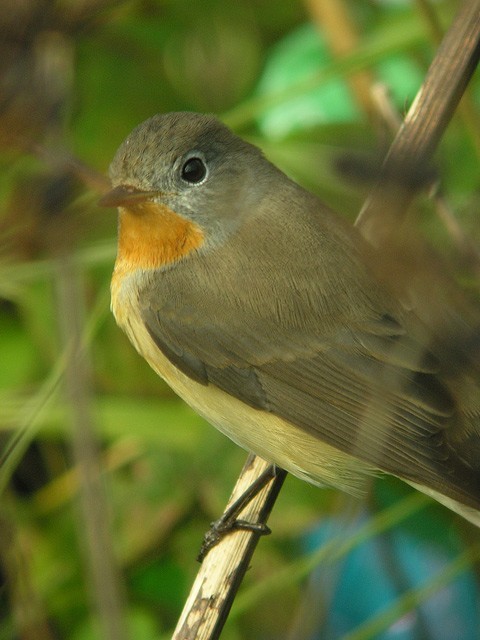
Red-breasted Flycatcher, South Gare, Cleveland The "Robin Flycatcher" (Photo: Ian Boustead)
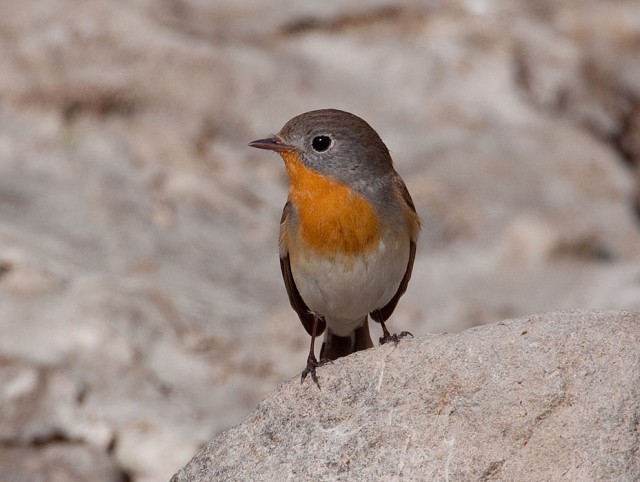
Red-breasted Flycatcher, Greece. Male Red-breasted Flycatchers are smart little birds; note the grey at the sides of the neck falls like a shawl and does not meet across the breast. (Photo: John Miller)
Red-breasted Flycatcher could be accurately named the Robin Flycatcher as the species exhibits some robin-like traits, and of course adult males have an orange breast! It is not a difficult species to identify, therefore. Although the females and first-winters lack the distinctive grey head and orange underparts, they make up for this with plenty of character. They zip around fly-catching, both off the ground and in the air; when perched they flick their wings and frequently cock their tails. They are very vocal and birds of this species are regularly located on call. Migrants either give a soft Blackcap-like "tck" or a low, dry rattle not unlike a Wren.
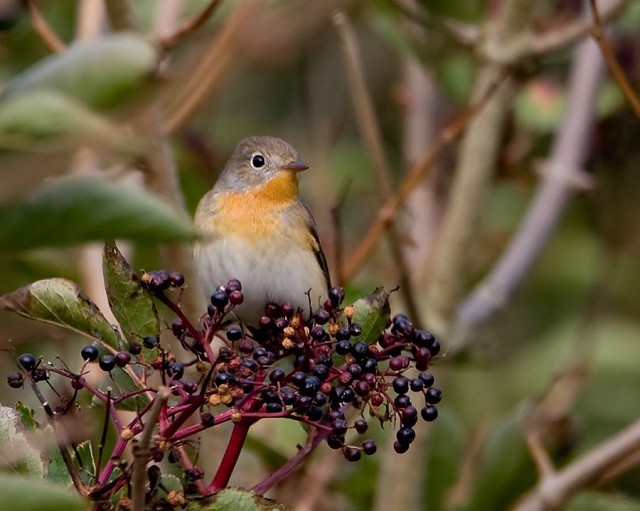
Red-breasted Flycatcher, Kilnsea, East Yorkshire A cracking little RBF, as they are affectionately known, feeding on elderberries. Note the orange throat spilling out over the upper breast. (Photo: Graham Catley)
Taiga Flycatchers are similarly shy but cheeky little birds and both species are smaller than the more familiar Pied Flycatcher. With their little round heads and slightly plump bodies they could be described as "dinky". The tail is long in proportion and boldly marked black with white bases. The distinctive tail pattern this combination creates is regularly flashed at the observer as the birds alternately cock and fan their tails. The eye appears large on the head and is highlighted by a pale whitish-buff orbital ring. The call of Taiga Flycatcher is more of a buzzing or chattering rattle somewhat angrier than RBF and delivered at a faster pace.

Adult male Taiga Flycatcher, a fetching combination of brown cap, red bib and matching grey waistcoat. (Photo: Hanne & Jens Eriksen)
Adult males of both species show a combination of warm brown upperparts with some grey around the face, and of course a red throat or breast. Red-breasted Flycatcher shows more extensive grey around the face that extends down on the breast sides. The throat and upper breast are washed with a warm orange glow that spills out over the upper breast. On Taiga Flycatcher the grey on the face is restricted to the supercilium with the cheeks and crown usually contrastingly brown. The orange patch is somewhat deeper in tone and restricted to the throat, with a grey wash wrapping round underneath. The Taiga's tail too shows a different and diagnostic pattern, as the upper tail-coverts are jet black, blacker than the tail feathers underneath. In Red-breasted Flycatcher the upper tail-coverts are browner and greyer and therefore generally not as dark as the tail.
In winter, as a rule, the male Red-breasted Flycatcher retains its summer plumage but Taiga Flycatchers tend to lose their red throats. In spring, first-summer male Red-throated Flycatchers have acquired a red throat but male Red-breasted Flycatchers still look like females in their first year. Male Red-breasted Flycatchers do not show a red breast until they reach second-summer plumage.
These differences in moult means that a bird in spring presenting a combination of both adult and juvenile-type plumage — i.e. a red throat and also buff fringes and tips to the wing feathers — can only be a Taiga Flycatcher. This is what set the bells ringing for the 2003 Flamborough Head individual.
Female and first-winter birds prove far more difficult to separate and this is where the combination of characters comes into play. To be confident about identifying a first-winter Taiga Flycatcher in the field, first you must spend some time studying it. Check and recheck the following features:
- The upper tail pattern: as with adult birds the longest upper tail-coverts are darker, more contrastingly black than the tail feathers in Taiga Flycatcher.
- On the underparts: Taiga Flycatcher shows a white throat and colder underparts; the body is white with a grey wash. Taiga Flycatcher therefore lacks the warm buff or peachy tones shown in these areas by Red-breasted Flycatcher.
- The bill: all-dark in Taiga Flycatcher, lacking the pale base shown by Red-breasted Flycatcher.
- Face pattern: many individual Taiga Flycatcher show a distinctly brown cap contrasting with the grey supercilium.
- Tertial pattern: in Taiga Flycatcher a narrow whitish border to the outer webs is apparent, ending in a small white spot on the tip. In Red-breasted Flycatcher this tertial fringe is more diffuse and the terminal spot is therefore more prominent as well as being buff-coloured. However, this is regarded to be a softer feature that can show much individual variation.
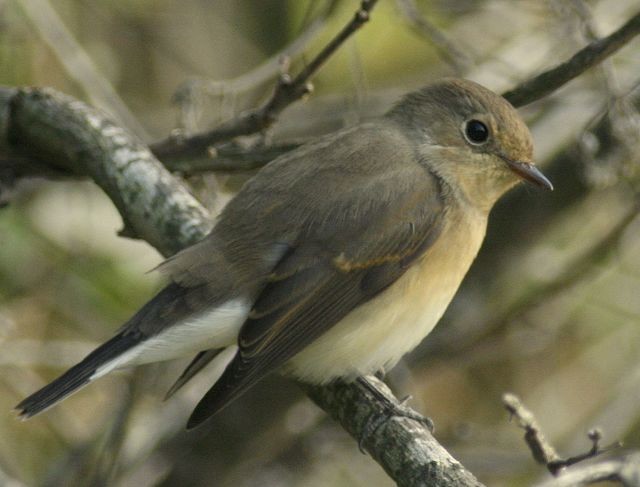
Red-breasted Flycatcher, Bulgaria A classic first winter parva. A combination of warm face, throat and breast and the tail feathers are distinctly darker than the upper tail-coverts. (Photo: Lee)
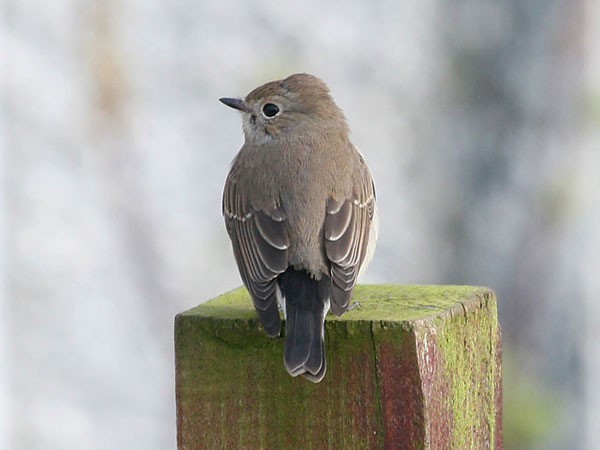
Taiga Flycatcher, Gloup, Yell, Shetland From above the upper tail-coverts are distinctly blacker than the tail. Note, too, the tertial pattern showing only a small terminal spot and neat whitish fringes to outer webs. (Photo: Rob Fray)
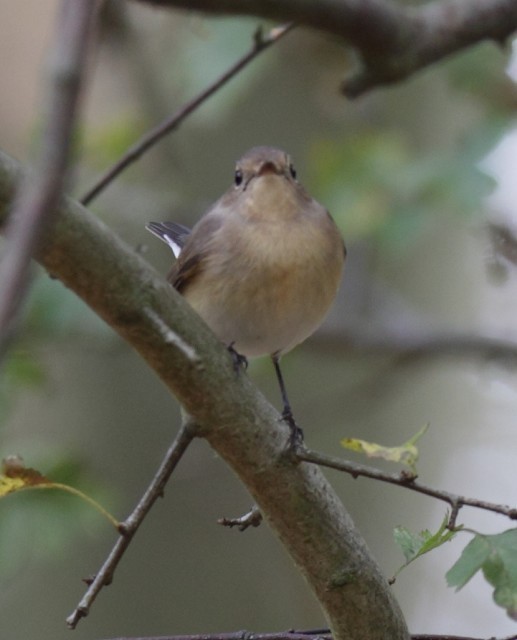
Red-breasted Flycatcher, Thorpeness, Suffolk This front-on view shows the warm underparts shown by a classic RBF and creamy-buff throat and breast, perhaps mirroring the adult male pattern (Photo: Chris Darby)
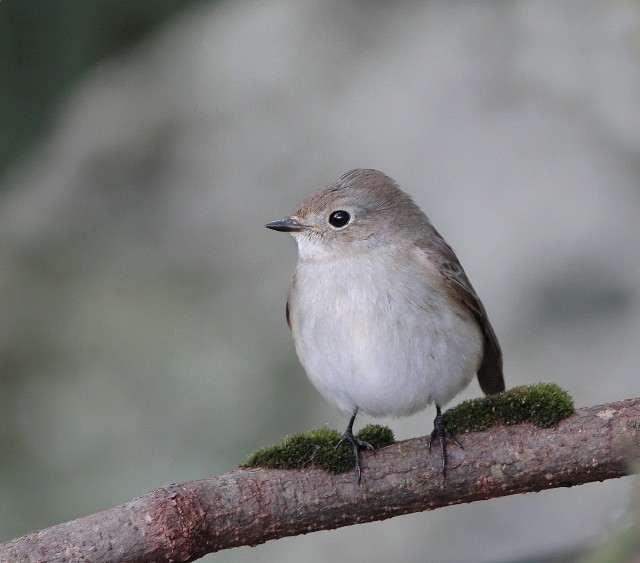
Taiga Flycatcher, Tresta, Fetlar, Shetland This view clearly shows the white throat of a Taiga Flycatcher. Note too the all-dark bill and the white underparts with a grey wash and no warm tones visible. (Photo: Robbie Brookes)
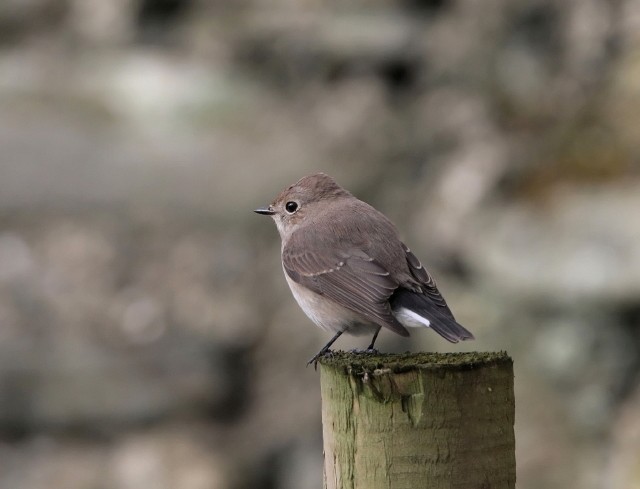
Taiga Flycatcher, Fetlar, Shetland The all-dark bill appears deeper than RBF with a slight upturn reminiscent of a Red-flanked Bluetail! (Photo: Robbie Brookes)
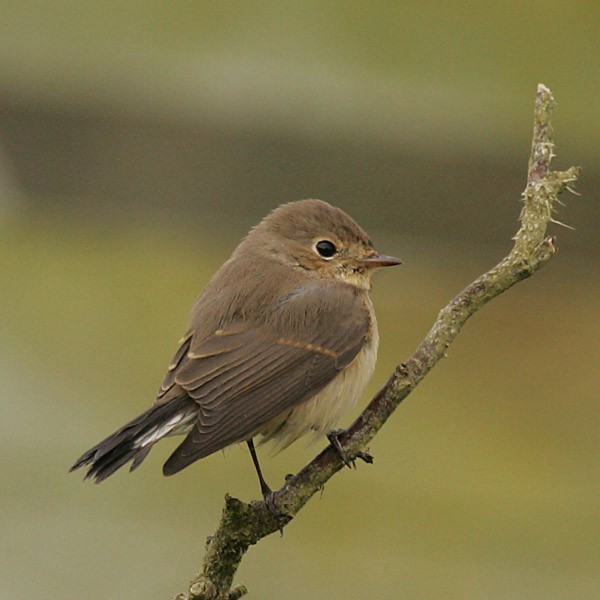
Red-breasted Flycatcher, Sumburgh, Mainland, Shetland This bird shows a classic RBF tertial pattern with very narrow fringes to the outer webs but a prominent buff terminal spot. (Photo: Tony Mills)
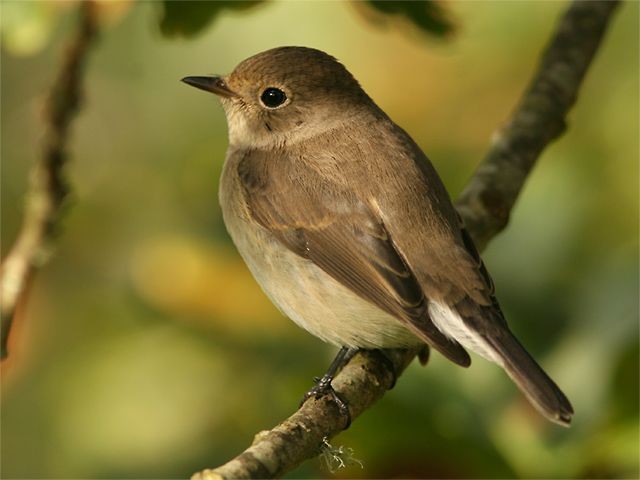
Red-breasted Flycatcher, St. Mary's, Isles of Scilly A potential pitfall: on this individual the bill appears all-dark, it has a brown-capped appearance and the tertials have a neat fringe lacking a prominent buff terminal spot. However, overall the bird appears to be too warm toned for a Taiga Flycatcher and the duller upper tail-coverts are a giveaway. (Photo: David H Hatton)
References
Collinson M., Svensson L., Knox A.G., Parkin D.T., Sangster G. Species limits in Red breasted Flycatcher British Birds 98:10 538–541
Lassey P.A., Taiga Flycatcher in East Yorkshire: new to Britain. British Birds 98 542–546.
Chapman M. Taiga Flycatcher in Shetland. British Birds 98:10 547–550
Cederroth C., Johansson C., Svensson L. Taiga Flycatcher in Sweden: the first record in western Europe. Birding World 12:11460–468
Many thanks to Hanne & Jens Eriksen of www.birdsoman.com for use of their picture.



